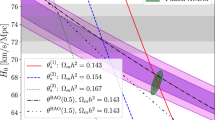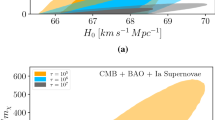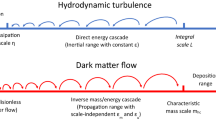Abstract
It is generally believed that the Universe began from a hot big bang. Among the clues to its very early history are the present day observations that the Universe is isotropic and homogeneous (as shown by the 3 K microwave background1 and galaxy counts2,3) and that there are about 109±1 photons per baryon4. Penrose and others5,6 argue that these two observations imply that the Universe was initially very nearly isotropic and homogeneous. Their arguments rely on absolute baryon conservation so that the baryon number of the Universe can be used as a fiducial to which the number of photons can be compared. In recently proposed grand unified theories of particle interactions, baryon number is not absolutely conserved7,8 and thus the baryon number of the Universe is no longer a constant. It is argued here that in the absence of this fiducial the photonJbaryon ratio is not a ‘footprint’ of the initial conditions, and therefore the initial singularity could well have been highly irregular as Misner suggested9.
This is a preview of subscription content, access via your institution
Access options
Subscribe to this journal
Receive 51 print issues and online access
$199.00 per year
only $3.90 per issue
Buy this article
- Purchase on Springer Link
- Instant access to full article PDF
Prices may be subject to local taxes which are calculated during checkout
Similar content being viewed by others
References
Smoot, G. F., Gorenstein, M. V. & Muller, R. A. Phys. Rev. Lett. 39, 898–901 (1977).
Peebles, P. J. E. Physical Cosmology, 31–42 (Princeton University Press, 1971).
Kron, R. G. thesis, Univ. Calif., Berkeley (1978).
Steigman, G. A. Rev. Astr. Astrophys. 14, 339–372 (1976).
Barrow, J. D. & Matzner, R. A. Mon. not. R. astr. Soc. 181, 719–727 (1977).
Penrose, R. in Einstein Centenary Volume (Cambridge University Press, 1979).
Georgi, H. & Glashow, S. L. Phys. Rev. Lett. 32, 438–441 (1974).
Pati, J. C. & Salam, A. Phys. Rev. D8, 1240–1251 (1973).
Misner, C. W. Astrophys. J. 151, 431–457 (1968).
Buras, A., Ellis, J., Gaillard, M. K. & Nanopoulos, D. V. Nucl. Phys. B135, 66–92 (1978).
Toussaint, B., Treiman, S. B., Wilczek, F. & Zee, A. Phys. Rev. D19, 1036–1045 (1979).
Dimopoulos, S. & Susskind, L. Phys. Rev. D18, 4500–4508 (1978).
Weinberg, S. Phys. Rev. Lett. 42, 850–853 (1979).
Ellis, J., Gaillard, M. K. & Nanopoulos, D. V. Phys. Lett. 80B, 360–365 (1979).
Toussaint, D. & Wilczek, F. Elementary Examples of Baryon Number Generation (Princeton preprint, 1978).
Yoshimura, M. Phys. Rev. Lett. 41, 281–284 (1978).
Turner, M. S. & Schramm, D. N. Nature 279, 303–305 (1979).
Goldman, T. J. & Ross, D. A. A New Estimate of the Proton Lifetime (Caltech preprint 68–704, 1979).
Reines, F. Search for Baryon Decay and Neutrino Oscillations (University of California at Irvine Rep. 10P 19–125, 1977).
Author information
Authors and Affiliations
Rights and permissions
About this article
Cite this article
Turner, M. On the isotropy and homogeniety of the Universe. Nature 281, 549–550 (1979). https://doi.org/10.1038/281549a0
Received:
Accepted:
Published:
Issue Date:
DOI: https://doi.org/10.1038/281549a0
Comments
By submitting a comment you agree to abide by our Terms and Community Guidelines. If you find something abusive or that does not comply with our terms or guidelines please flag it as inappropriate.



